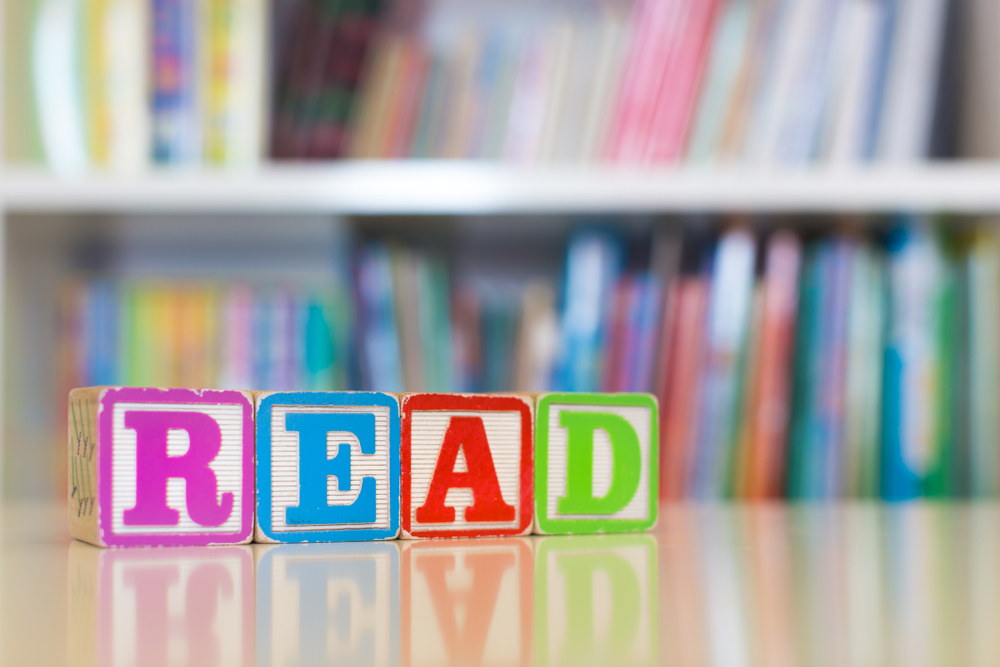
Early literacy skills correlate with future success in school. A child who struggles to read in first grade has a 90 percent likelihood of struggling to read in fourth grade. In addition, reading proficiency in third grade is a strong indicator of the successful completion of high school; children who do not meet benchmark reading levels in third grade are four times more likely to dropout of high school.
While statistics show that early reading success resonates beyond elementary school, half of California’s third graders do not meet grade-level reading benchmarks. Crucially, the state also does not track reading data or proficiency until third grade. This means that parents might have little understanding about their child’s struggles until fourth grade when third grade reading assessment scores are reported.
In California, the gap between proficient readers and those who are struggling is greater when accounting for ethnicity. According to Edsource, two out of three Black children and 61 percent of Latinx children read below grade level in third grade. However, only 37 percent of Caucasian third graders read below grade level.
Why do California students struggle to read proficiently by third grade? Decoding California’s failing marks in literacy might focus on three core factors: curriculum, student language barriers, and funding.
California’s Reading Curriculum
The crux of the reading struggles for California’s youth might be tied to the state’s instructional methodologies related to literacy. Edsource noted that California does not currently have a plan in place to support reading proficiency by third grade. In addition, reading instruction could differ from district to district.
Schools in California aren’t obliged to share literacy proficiency with parents as it relates to district or school success and statistics. In addition, Edsource also explained that schools also don’t have to reach out to parents related to a child’s literacy success or struggles.
Parents could be completely in the dark about their child’s reading proficiency until they receive data in fourth grade. However, a child that is reading below grade level in fourth grade might struggle to catch up if they are able to catch up at all.
Schools in California also might not teach students the ‘science of reading.’ Instead, districts or individual schools could be relying on outdated and ineffective methods for teaching literacy.
What is the science of reading? This method of instruction is currently being embraced by districts across the country. The ‘science of reading’ focuses on teaching literacy as it relates to phonemic awareness and phonics skills. Instead of prompting children to use story pictures or illustrations to help decipher text, the science of reading enforces decoding skills and mastering sounds, blends and letter identification.
Breaking down reading into a science could, theoretically, help struggling readers understand the core fundamentals of literacy. When a child is able to quickly decode words and sentences, reading can focus on finding deeper meaning of the text. If a child cannot decode or identify basic sounds and blends, they could fail to master the skills needed to become a proficient reader.
While the California Department of Education issues a list of educational materials for districts, Edsource explained that most districts don’t pull from this list and, according to a source from the article, California’s list doesn’t offer the best options.

Adding to the complexities of California’s seismic literacy struggles is the language divide that exists in the state. Many students do not speak English as their first language, and teaching literacy to children who are struggling to master a new language poses its own set of challenges. Can reading instruction be the same for children who aren’t fluent in English?
Edsource interviewed Shelly Spiegel Coleman, who serves as a strategic adviser for Californians Together, which is an organization that advocates for English Learners.
“Think about our young kids who come to kindergarten who have spoken English for five years before they step into the classroom versus kids who don’t know one word of English,” said Spiegel Coleman to Edsource. “You start dissecting English. Breaking up those sounds and trying to put them together means nothing for a kid who doesn’t know a word of English. It’s a game, it’s not literacy.”
Is California Allocating Funding to Fix the Problem?
With reading proficiency in third grade at best a 50 percent probability for many California students, parents might wonder if the state is adding financial resources for districts to offer better literacy instruction. While Edsource explained that Governor Gavin Newsom tried to pass $500 million in funding for reading coaches, that allocation was sliced to $250 million.
In addition, a tool that screens for dyslexia also failed to make headway. The issue was related to the fear that English Learners might be inappropriately diagnosed as dyslexic.
While many states are implementing focused comprehensive plans to ensure literacy success, California seems to be stalled in its attempt to make headway. As California already has the lowest literacy rate in the country, the funding limitations combined with the lack of clear guidance for school districts and the failure to track early literacy data of students could lead to academic aftershocks for struggling readers.
How Can California Parents Help Their Children?
Early reading success can lead to a richer and more positive academic experience, as reading is fundamental to learning. Falling behind grade-level benchmarks doesn’t simply mean that a child cannot read grade-level books, those struggles also could cause children to have difficulty deciphering and understanding more complex readings for science, social studies and other subjects.
If parents aren’t receiving reading reports, how can they know if their child is struggling? While some schools might not disseminate literacy reports, others might communicate regularly with parents. Unfortunately, some parents might not realize their child has fallen behind until they receive scores from their child’s third-grade assessments.
However, parents don’t have to rely on teacher communiqués to understand their child’s reading level and proficiency. If a teacher hasn’t communicated a child’s reading level to parents, this information can be requested.
In addition, parents can read regularly with children to better understand their child’s confidence and ability. For many families, though, time is precious. Some parents might not have the opportunity to read to children or sit with them to work on reading skills.

Every Child Should Have the Gift of Literacy
Since early literacy impacts later education success, many parents would assume that every child in the country should grow up to learn how to read. However, the gift of literacy shouldn’t be taken for granted.
Although California lags behind the rest of the country in literacy, one out of four children in the U.S. will grow up without learning how to read. No parent would expect their child to become part of this statistic, and, yet, many children will fail to learn how to read.
In California, the struggle to boost literacy rates might be a war that parents try to win at home instead of in the classroom. Ultimately, it might be up to parents to ensure that their child doesn’t become a statistic.
While New Hampshire boasts a literacy rate of more than 94 percent, only 76.9 percent of Californians are literate. If parents struggle to read or don’t have materials at home for children, the reading gap could widen.
What can parents do? When resources are limited, do parents have options?
No child is doomed to be a statistic. Even in areas where parents struggle to find reading materials for their children, there are still options and ways to help a struggling reader.
Dolly Parton’s Imagination Library is available for children in many states including California. The library provides free books to children (birth to age five), and parents simply need to complete a form.
Local libraries could provide programs for young children, too. Some offer free story time events. Libraries also provide access to free books and materials.
How Can Parents Bridge a Learning Gap?
Helping a child catch up to reading benchmarks after they have fallen behind could be difficult for parents, especially if third-grade assessments reveal that a child is years behind the benchmark expectations.
For parents with children in kindergarten through second grade, working with children at home to reinforce reading skills could be the best way to ensure that a reading struggle is caught early and that small struggles don’t snowball into larger learning gaps. Since most elementary students are expected to be ready daily, parents can use this opportunity to gauge their child’s understanding of books and stories. Ask children questions about the book and focus on w/h questions (who, what, where, when and how).
Some parents could prepare children for learning to read before kindergarten. For parents who have the luxury of time, reading to children every day can prepare them for the reading journey.
Early readers also could benefit from using apps that help them master sounds and sight words. There are many free apps available via Google Play and the App Store that can help children develop these key literacy skills.
Many apps are designed as games. Children could use apps to learn their alphabet and master the sounds of each letter. Sight word apps often include flashcards to help children memorize their list of words.
For families in lower-income communities, though, resources could be scarce. Children in poorer school districts and communities could have fewer books available. Some children also might not have access to technology that allows them to use apps or reading programs.
How to Spot an Early Reading Struggle
Parents might suspect that their child is struggling to read, and early intervention could be vital to helping them catch up. Not all parents pick up on the struggle, but all parents can reach out to teachers to better understand their child’s reading level and how it compares to grade-level expectations.
Parents also could request more formal assessments related to receiving additional reading intervention. Schools might need to initiate evaluations for these interventions; in addition, a child also could qualify for an Individualized Education Program (IEP) related to an underlying medical diagnosis or learning disorder.
Not every child qualifies for additional intervention or specialized reading guidance, however. For children who struggle but who cannot receive extra help, parents can talk to their child’s teacher for guidance. Some teachers could offer resources for parents to use at home.
In addition, some communities offer programs to help children with reading or other subjects. Local organizations could offer free tutoring after school.

The Aftershocks of Reading Struggles
California’s struggles to help students gain reading proficiency might be a battle that rages on. Unfortunately, children who fall behind in reading might feel the brunt force of the educational aftershocks.
Parents who don’t know that their child is struggling with reading might not have the means to help their child reach grade-level benchmarks. As a child falls behind, other subjects can be impacted. Literacy is linked to school success, but what many parents might not realize is that the majority of high school graduates don’t read proficiently or above. In fact, 63 percent of high schoolers who receive their diploma aren’t proficient readers.
While California’s lack of a comprehensive reading plan might indicate a need for better literacy methodologies and instruction in the state, the fact that more than 60 percent of high school graduates aren’t reading at a proficient level (or above) points to a much larger issue. Literacy struggles are a national concern and aren’t relegated only to a single state.
Every night around the country millions of school children clock their nightly reading minutes. How many of them, though, will simply ride out the clock? How many of them love what they read? How many of them can fluently read the book in their hands?
Ultimately, California’s literacy gap highlights the reality that reading in the U.S. might not be such an understood science. If more states move towards teaching the science of reading to help children decipher the code of words and the intricacies of sounds and letters, perhaps the seismic shift will lead to higher literacy rates.
For now, though, in states that struggle to teach the core elements of reading, children may continue to fall through the cracks and face an aftershock of academic repercussions as they move through the education system.

 Español
Español